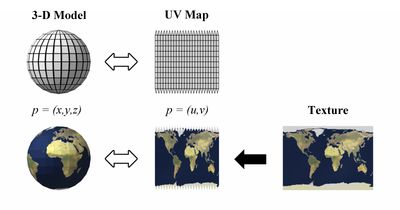UV coordinates
UV mapping is the geometric modeling process of creating a 2D image that represents a 3D model.
UV mapping
The UV coordinate system is used for texturing polygon objects, where u and v describe the texture coordinates . The letters u and v for the coordinates are chosen arbitrarily and have no linguistic meaning (see letters x, y and z in the Cartesian coordinate system). Each point of the polygon object is given a unique texture position. If the x-values and y-values are used for the position of the polygon, a distorted texture can only be clearly positioned using deviating UV coordinates.
UV texturing allows the user to texturize polygons that represent a 3D model with an image. This image is called a UV Texture Map, but it's actually just a simple image.
In the example on the right, a sphere is provided with a checkered texture, first without and then with UV mapping. Without UV mapping, the checkered tiling and the texture are cut out of the sphere. With UV mapping, the UV space and the UV points are applied to the tile according to their latitude and longitude .
If a model is created as a polygon mesh using 3D graphics software , the UV coordinates can be created for each individual vertex in the mesh. When the scene is rendered, each polygon is given the appropriate texture.
A UV map can either be created by software, manually by the artist, or a combination of both methods. Often a UV map is generated automatically and the artist adjusts it to minimize the number of overlaps and gaps. If the model is symmetrical, the artist can superimpose opposing polygons to texture both sides at the same time.
UV coordinates are applied over surfaces, not vertex. This means that a split vertex can have different UV coordinates in each of its triangles, so that neighboring triangles can be clipped and positioned in different places on the texture map.
The UV mapping process, in its simplest form, requires at least three steps: unfolding the mesh, creating the texture, and applying the texture.
Search of UV on a sphere
UV coordinates represent a projection of the space vectors onto the xy surface.




